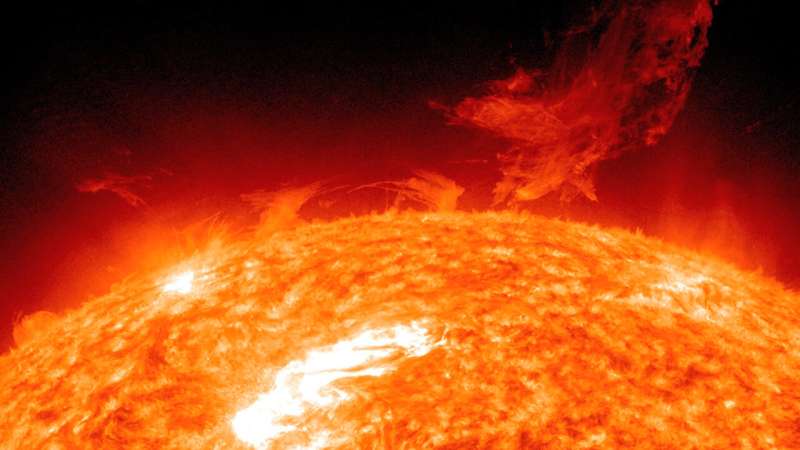This article has been reviewed according to Science X's editorial process and policies. Editors have highlighted the following attributes while ensuring the content's credibility:
fact-checked
peer-reviewed publication
trusted source
written by researcher(s)
proofread
Colliding plasma ejections from the sun generate huge geomagnetic storms

The sun periodically ejects huge bubbles of plasma from its surface that contain an intense magnetic field. These events are called coronal mass ejections, or CMEs. When two of these ejections collide, they can generate powerful geomagnetic storms that can lead to beautiful auroras but may disrupt satellites and GPS back on Earth.
On May 10, 2024, people across the Northern Hemisphere got to witness the impact of these solar activities on Earth's space weather.
Two merging CMEs triggered the largest geomagnetic storm in two decades, which manifested in brightly colored auroras visible across the sky.
I'm a solar physicist. My colleagues and I aim to track and better understand colliding CMEs with the goal of improving space weather forecasts. In the modern era, where technological systems are increasingly vulnerable to space weather disruptions, understanding how CMEs interact with each other has never been more crucial.
Coronal mass ejections
CMEs are long and twisted—kind of like ropes—and how often they happen varies with an 11-year cycle. At the solar minimum, researchers observe about one a week, but near the solar maximum, they can observe, on average, two or three per day.
When two or more CMEs interact, they generate massive clouds of charged particles and magnetic fields that may compress, merge or reconnect with each other during the collision. These interactions can amplify the impact of the CMEs on Earth's magnetic field, sometimes creating geomagnetic storms.
Why study interacting CMEs?
Nearly one-third of CMEs interact with other CMEs or the solar wind, which is a stream of charged particles released from the outer layer of the sun.
In my research team's study, published in May 2024 in Astronomy & Astrophysics, we found that CMEs that do interact or collide with each other are much more likely to cause a geomagnetic storm—two times more likely than an individual CME. The mix of strong magnetic fields and high pressure in these CME collisions is likely what causes them to generate storms.
During solar maxima, when there can be more than 10 CMEs per day, the likelihood of CMEs interacting with each other increases. But researchers aren't sure whether they become more likely to generate a geomagnetic storm during these periods.
Scientists can study interacting CMEs as they move through space and watch them contribute to geomagnetic storms using observations from space- and ground-based observatories.
In this study, we looked at three CMEs that interacted with each other as they traveled through space using the space-based observatory STEREO. We validated these observations with three-dimensional simulations.
The CME interactions we studied generated a complex magnetic field and a compressed plasma sheath, which is a layer of charged particles in the upper atmosphere that interacts with Earth's magnetic field.
When this complex structure encountered Earth's magnetosphere, it compressed the magnetosphere and triggered an intense geomagnetic storm.

This same process generated the geomagnetic storm from May 2024.
Between May 8 and May 9, multiple Earth-directed CMEs erupted from the sun. When these CMEs merged, they formed a massive, combined structure that arrived at Earth late on May 10, 2024. This structure triggered the extraordinary geomagnetic storm many people observed. People even in parts of the southern U.S. were able to see the northern lights in the sky that night.
More technology and higher stakes
Scientists have an expansive network of space- and ground-based observatories, such as the Parker Solar Probe, Solar Orbiter, the Solar Dynamics Observatory and others, available to monitor the heliosphere—the region surrounding the sun—from a variety of vantage points.
These resources, coupled with advanced modeling capabilities, provide timely and effective ways to investigate how CMEs cause geomagnetic storms. The sun will reach its solar maximum in the years 2024 and 2025. So, with more complex CMEs coming from the sun in the next few years and an increasing reliance on space-based infrastructure for communication, navigation and scientific exploration, monitoring these events is more important than ever.
Integrating the observational data from space-based missions such as Wind and ACE and data from ground-based facilities such as the e-Callisto network and radio observatories with state-of-the-art simulation tools allows researchers to analyze the data in real time. That way, they can quickly make predictions about what the CMEs are doing.
These advancements are important for keeping infrastructure safe and preparing for the next solar maximum. Addressing these challenges today ensures resilience against future space weather.
More information: Shirsh Lata Soni et al, CMEs evolve in the interplanetary medium to double their predicted geo-effectiveness, Astronomy & Astrophysics (2024). DOI: 10.1051/0004-6361/202347552
Journal information: Astronomy & Astrophysics
Provided by The Conversation
This article is republished from The Conversation under a Creative Commons license. Read the original article.![]()




















